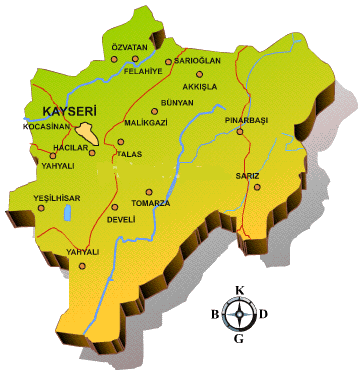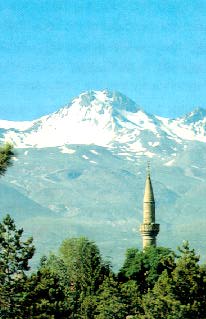| Kayseri... |
|
An ever snowy peak, rising magnificently over the Central Anatolian plateau, is Mount Erciyes (3,196 m), an extinct volcano
featuring the surrounding land. Those who visit Kayseri, the city situated at the skirts of this mountain, firstly come to
view this majestic sight. Moving towards the inner city, they will be amazed by the different appearance created by the
elegant minarets and domes of the mosques, and high city walls. 314 km from Ankara, this province forms a composition of
history and nature, and possesses many special features both as an ancient site and as a present-day tourist center. The
city is full of many old Turkish baths, fountains, tombs, inns, mosques, and medresses. Mount Erciyes is the most
outstanding figure in this region, not only with its fascinating scenery but also with the opportunities it offers for,
winter sports. It is a beautiful ski-resort with many facilities, and there also exist several areas suitable for
mountaineering. At the foot of Mount Erciyes are the Sultan Marshes, 50 kms south of Kayseri. Birds of 130 species are to
be found here and it is an interesting and lovely spot for bird watchers. Besides the beauties granted by nature, Kayseri
enjoys the many gifts of history, being a settlement area approximately 5000 years old. The city played different roles for
differing duration throughout its long past. By the 2nd millenium BC, the district was one of the commercial
centers of the Hittites. The towns of Kultepe and Karahoyuk of Kanesh were two of these trade cities, named as
"Karums" in that period. In the later ages, the city constituted one of the cornerstones of Cappadocia after
which it became a center of Christianity. In the AD 6th century, it was occupied by the Byzantines who
surrounded the city with high walls. Later saw the age of Seljuk rule, during which the area was endowed with numerous
monumental works. With respect to the historical signs which have remained from all these periods, the Huand (Mahperi)
Hatun Mosque and Medresse, and the Mahperi Hatun Mausoleum are of importance, each dating back to the 13th
century. "Kumbets", which are circular tombs with domed or conical roofs, named Doner, Cifte and Sircali, are
also attractive places to see with their distinctively fine decoration. In the town of Develi, there are the old Seljuk
buildings of Ulu Mosque, Seyid-i Serif, and Develi tomb; on the Sivas road 46 kms north of Kayseri, is the Sultan Han, a
caravanserai constructed during the reign of Alaeddin Keykubat.
|
|

|


 352...
352...
 38...
38...
 1,049,659...
1,049,659...
 16,917...
16,917...
 35 E 30 - 38 N 43...
35 E 30 - 38 N 43...




